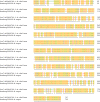Supraoptimal Iron Nutrition of Brassica napus Plants Suppresses the Iron Uptake of Chloroplasts by Down-Regulating Chloroplast Ferric Chelate Reductase
- PMID: 34093616
- PMCID: PMC8172622
- DOI: 10.3389/fpls.2021.658987
Supraoptimal Iron Nutrition of Brassica napus Plants Suppresses the Iron Uptake of Chloroplasts by Down-Regulating Chloroplast Ferric Chelate Reductase
Abstract
Iron (Fe) is an essential micronutrient for plants. Due to the requirement for Fe of the photosynthetic apparatus, the majority of shoot Fe content is localised in the chloroplasts of mesophyll cells. The reduction-based mechanism has prime importance in the Fe uptake of chloroplasts operated by Ferric Reductase Oxidase 7 (FRO7) in the inner chloroplast envelope membrane. Orthologue of Arabidopsis thaliana FRO7 was identified in the Brassica napus genome. GFP-tagged construct of BnFRO7 showed integration to the chloroplast. The time-scale expression pattern of BnFRO7 was studied under three different conditions: deficient, optimal, and supraoptimal Fe nutrition in both leaves developed before and during the treatments. Although Fe deficiency has not increased BnFRO7 expression, the slight overload in the Fe nutrition of the plants induced significant alterations in both the pattern and extent of its expression leading to the transcript level suppression. The Fe uptake of isolated chloroplasts decreased under both Fe deficiency and supraoptimal Fe nutrition. Since the enzymatic characteristics of the ferric chelate reductase (FCR) activity of purified chloroplast inner envelope membranes showed a significant loss for the substrate affinity with an unchanged saturation rate, protein level regulation mechanisms are suggested to be also involved in the suppression of the reduction-based Fe uptake of chloroplasts together with the saturation of the requirement for Fe.
Keywords: Brassica napus; FCR activity; FRO7; chloroplast; iron allocation; iron nutrition; iron uptake.
Copyright © 2021 Sági-Kazár, Zelenyánszki, Müller, Cseh, Gyuris, Farkas, Fodor, Tóth, Kovács, Koncz, Visnovitz, Buzás, Bánkúti, Bánáti, Szenthe and Solti.
Conflict of interest statement
BB and FB were employed by company RT-Europe Non-profit Research Ltd. KS was employed by company Carlsbad Research Organization Center Ltd. The remaining authors declare that the research was conducted in the absence of any commercial or financial relationships that could be construed as a potential conflict of interest.
Figures









Similar articles
-
The developmental and iron nutritional pattern of PIC1 and NiCo does not support their interdependent and exclusive collaboration in chloroplast iron transport in Brassica napus.Planta. 2020 Apr 15;251(5):96. doi: 10.1007/s00425-020-03388-0. Planta. 2020. PMID: 32297017 Free PMC article.
-
Functional characterization of the chloroplast ferric chelate oxidoreductase enzyme.New Phytol. 2014 May;202(3):920-928. doi: 10.1111/nph.12715. Epub 2014 Feb 7. New Phytol. 2014. PMID: 24506824
-
Chloroplast Fe(III) chelate reductase activity is essential for seedling viability under iron limiting conditions.Proc Natl Acad Sci U S A. 2008 Jul 29;105(30):10619-24. doi: 10.1073/pnas.0708367105. Epub 2008 Jul 22. Proc Natl Acad Sci U S A. 2008. PMID: 18647837 Free PMC article.
-
The diverse roles of FRO family metalloreductases in iron and copper homeostasis.Front Plant Sci. 2014 Mar 21;5:100. doi: 10.3389/fpls.2014.00100. eCollection 2014. Front Plant Sci. 2014. PMID: 24711810 Free PMC article. Review.
-
A Critical Review of Methodologies for Evaluating Iron Fertilizers Based on Iron Reduction and Uptake by Strategy I Plants.Plants (Basel). 2024 Mar 13;13(6):819. doi: 10.3390/plants13060819. Plants (Basel). 2024. PMID: 38592963 Free PMC article. Review.
Cited by
-
Iron uptake of etioplasts is independent from photosynthesis but applies the reduction-based strategy.Front Plant Sci. 2023 Aug 11;14:1227811. doi: 10.3389/fpls.2023.1227811. eCollection 2023. Front Plant Sci. 2023. PMID: 37636109 Free PMC article.
-
Iron in leaves: chemical forms, signalling, and in-cell distribution.J Exp Bot. 2022 Mar 15;73(6):1717-1734. doi: 10.1093/jxb/erac030. J Exp Bot. 2022. PMID: 35104334 Free PMC article. Review.
-
Iron Supplement-Enhanced Growth and Development of Hydrangea macrophylla In Vitro under Normal and High pH.Cells. 2021 Nov 13;10(11):3151. doi: 10.3390/cells10113151. Cells. 2021. PMID: 34831377 Free PMC article.
References
-
- Basa B., Lattanzio G., Solti Á, Tóth B., Abadía J., Fodor F., et al. (2014). Changes induced by cadmium stress and iron deficiency in the composition and organization of thylakoid complexes in sugar beet (Beta vulgaris L.). Environ. Exp. Bot. 101 1–11. 10.1016/j.envexpbot.2013.12.026 - DOI
LinkOut - more resources
Full Text Sources

